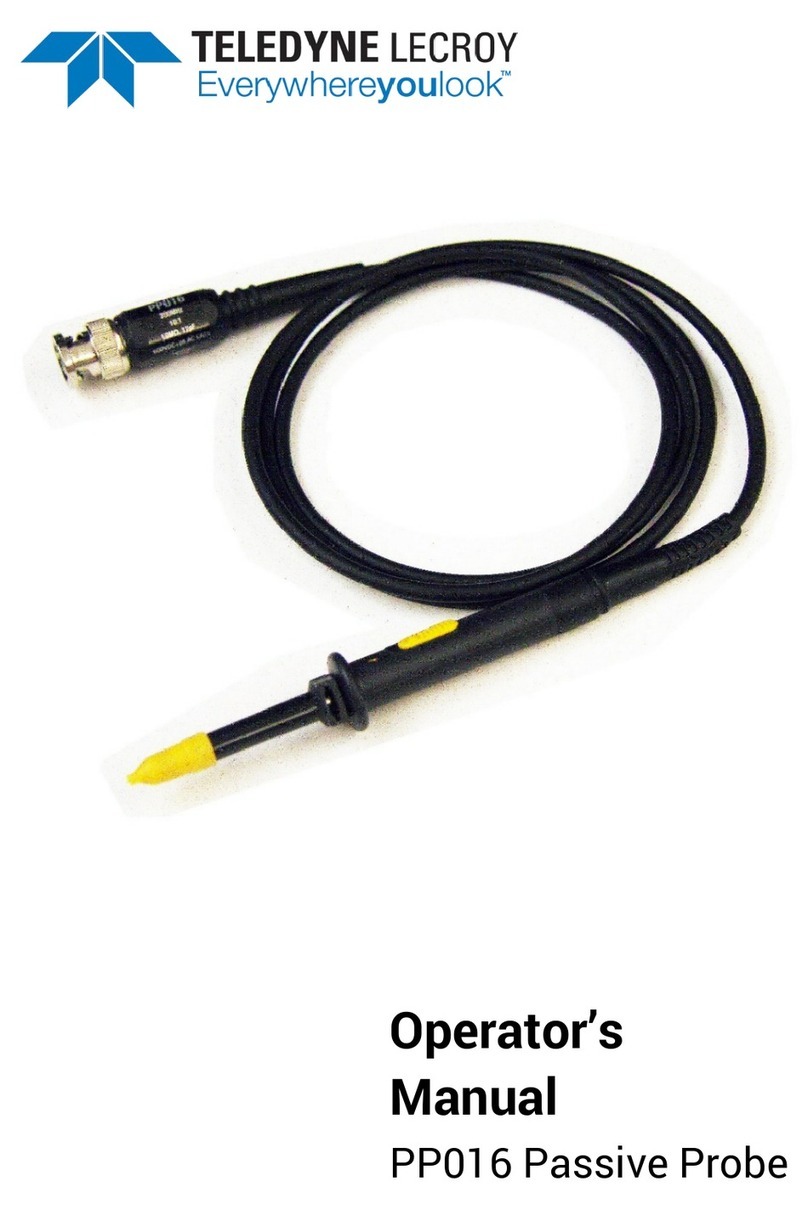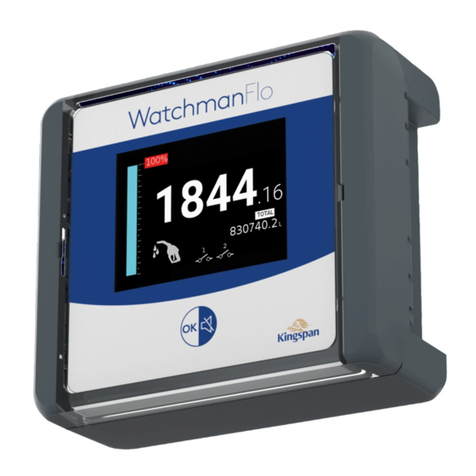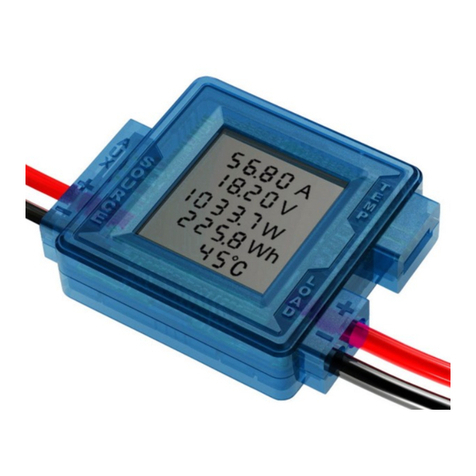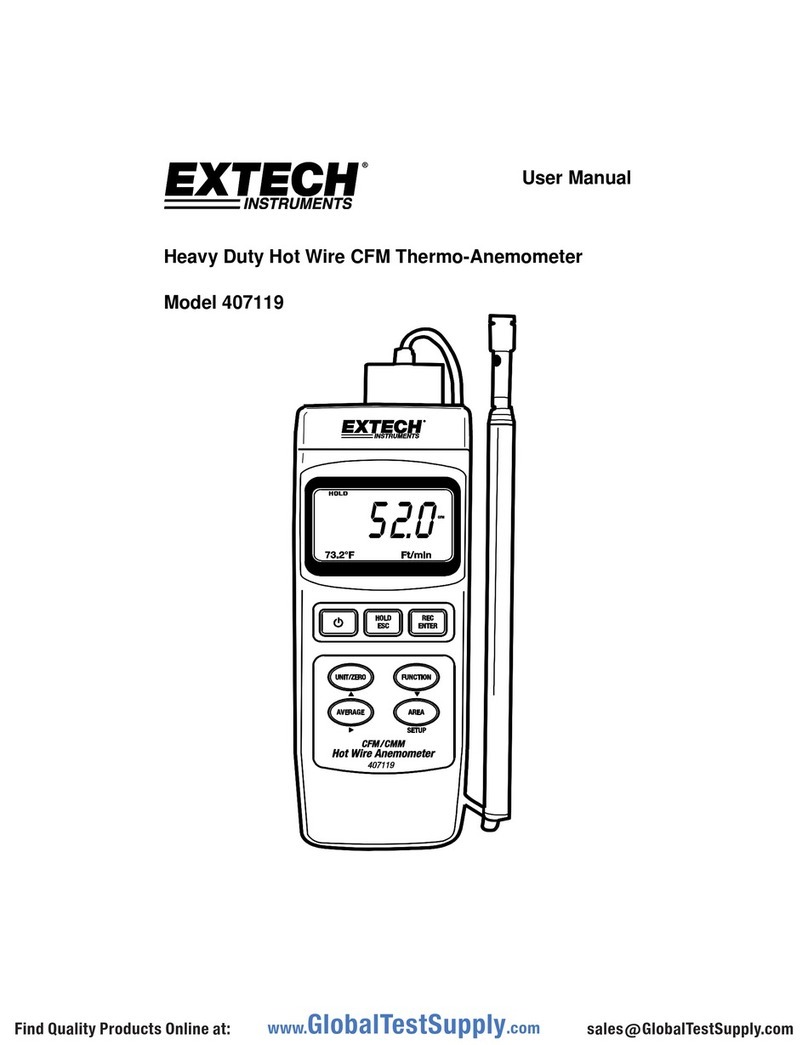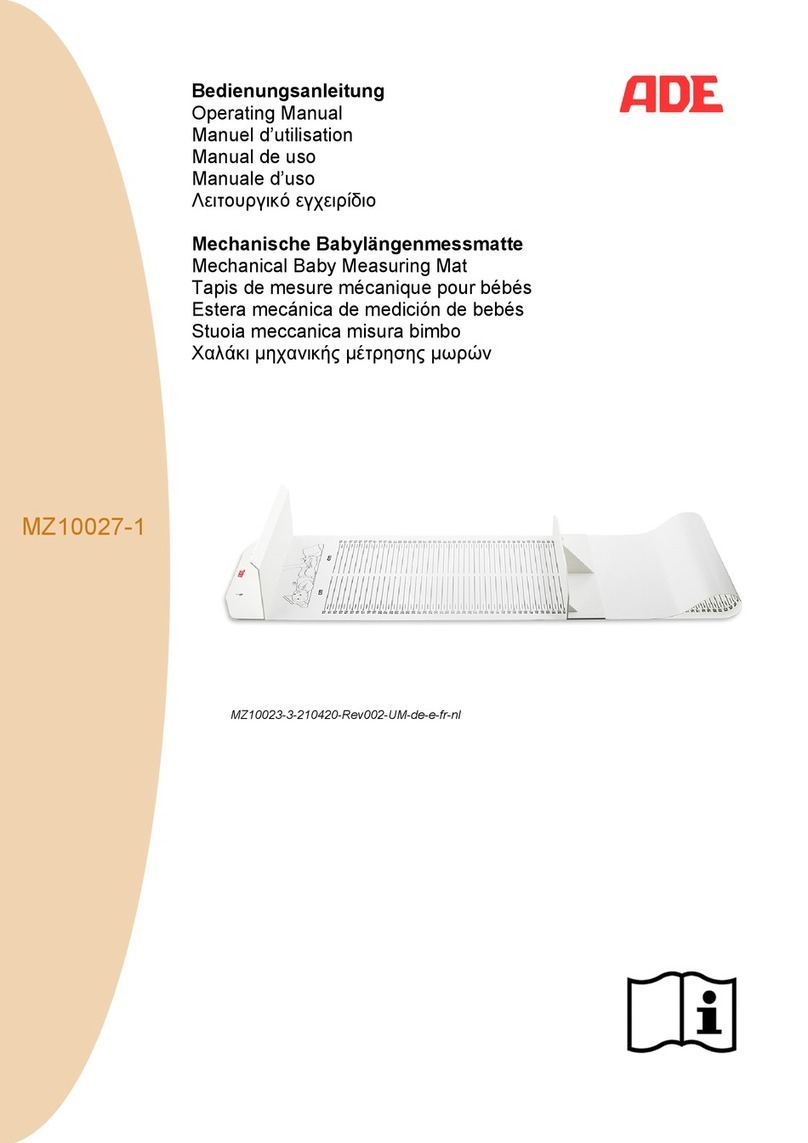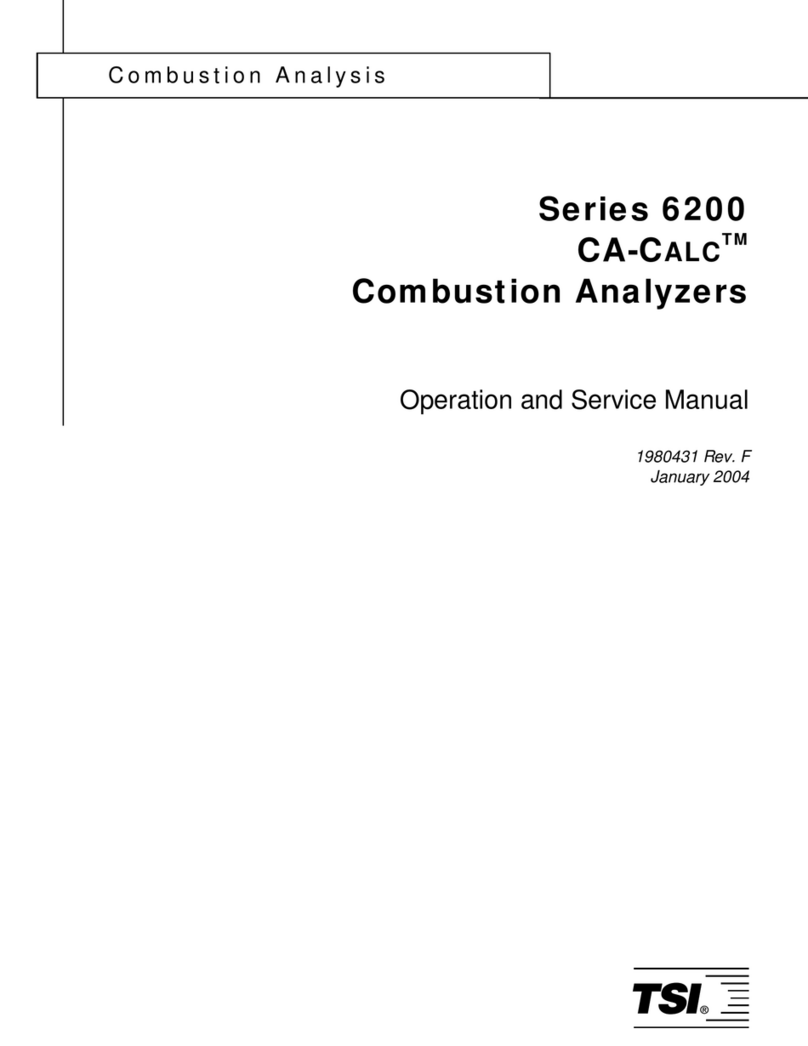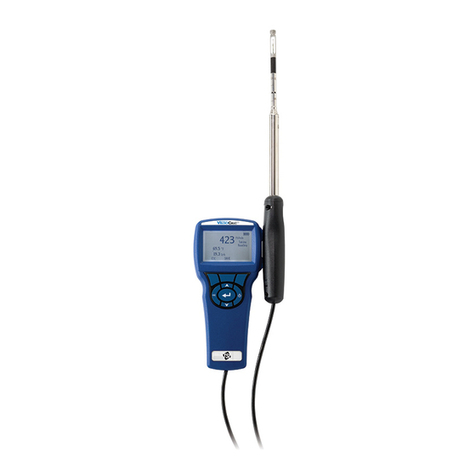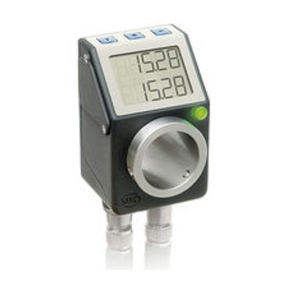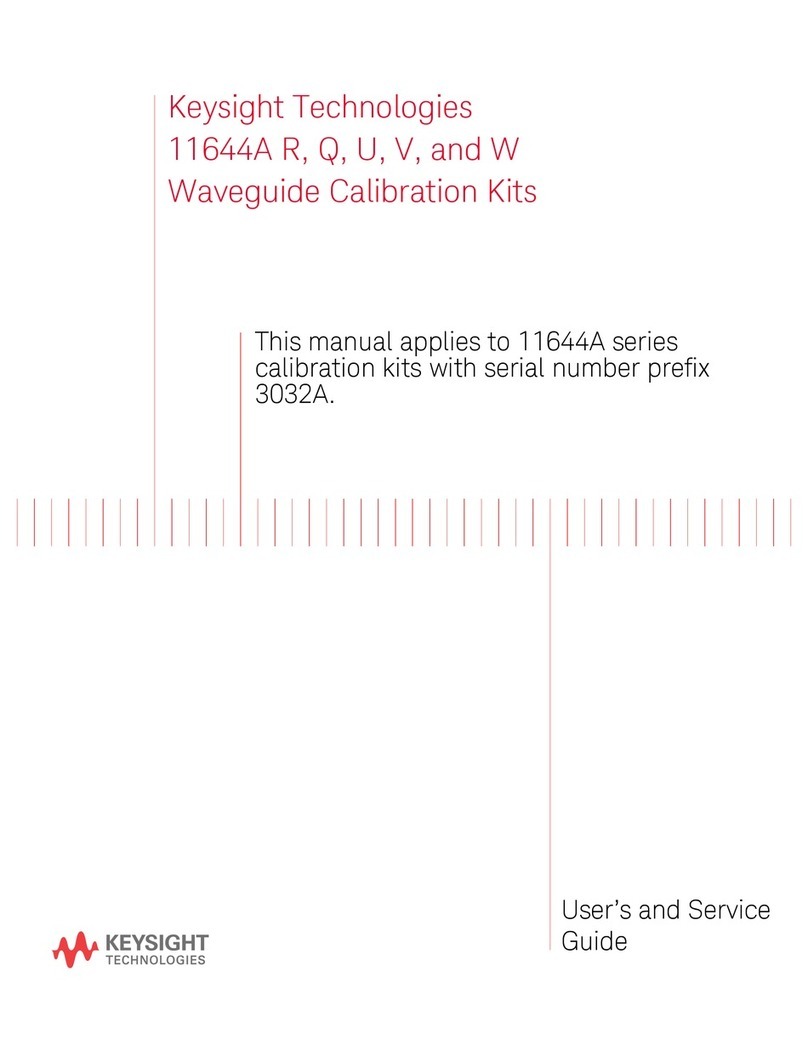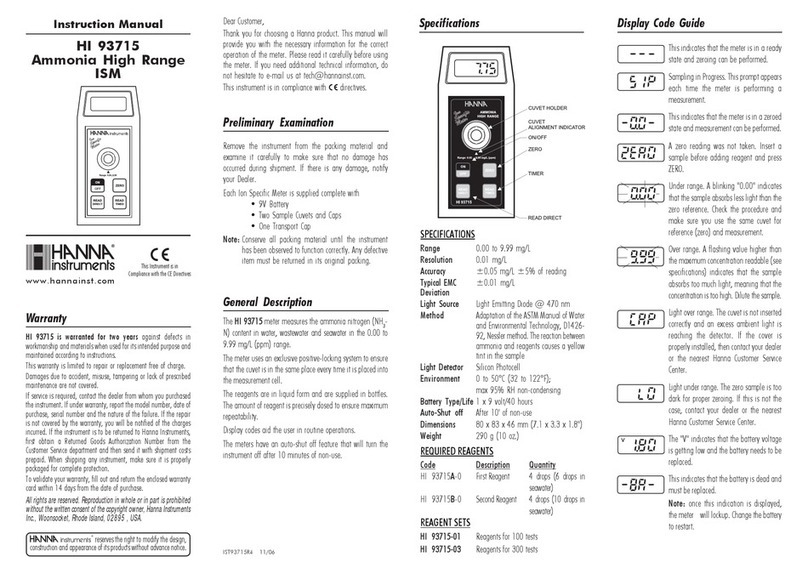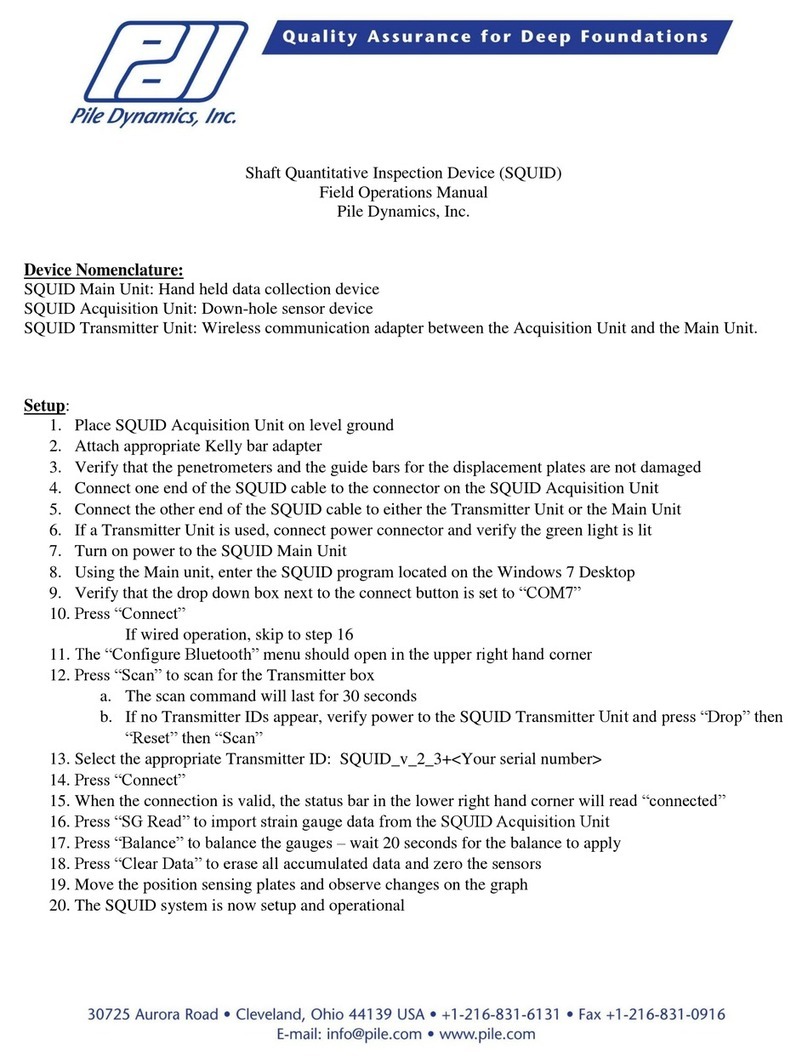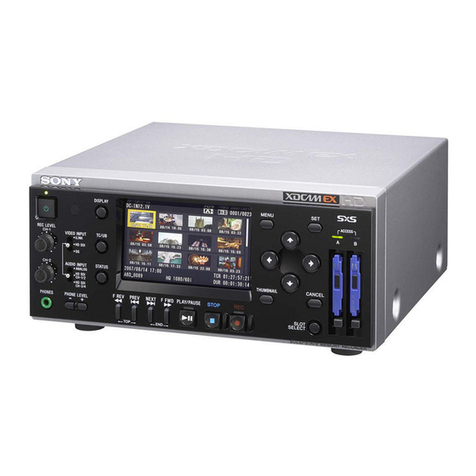Met One E-BAM User manual

Met One Instruments, Inc.
1600 NW Washington Blvd.
Grants Pass, OR 97526
Telephone: (541) 471-7111
Facsimile: (541) 471-7116
www.metone.com
E-BAM Particulate Monitor Operation Manual - © Copyright 2019 Met One Instruments, Inc. All Rights Reserved
worldwide. No part of this publication may be reproduced, transmitted, transcribed, stored in a retrieval system, or translated
into any other language in any form without the written permission of Met One Instruments, Inc.
E-BAM
PARTICULATE MONITOR
OPERATION MANUAL
E-BAM-9805 REV B

E-BAM-9805 Manual Rev B.docx Page 2

E-BAM-9805 Manual Rev B.docx Page 3
Table of Contents
1
INTRODUCTION 6
1.1 About This Manual........................................................................................................... 6
1.2 Technical Service............................................................................................................. 6
1.3 E-BAM: Environmental Beta Attenuation Monitor............................................................. 6
1.4 Beta Radiation Safety Statement..................................................................................... 7
1.5 E-BAM Specifications....................................................................................................... 8
2
E-BAM INSTALLATION AND COMMISSIONING 9
2.1 Unpacking........................................................................................................................ 9
2.2 Accessories...................................................................................................................... 9
2.3 Assembling the E-BAM .................................................................................................. 10
2.4 Electrical Connections.................................................................................................... 13
2.5 Power-up and Automatic Operation ............................................................................... 13
2.6 Power-up Settings Verification and Automatic Self-Test................................................ 14
2.7 Configuring External Sensors......................................................................................... 16
2.7.1 Configuring the 597A Sensor......................................................................................... 16
2.7.2 Changing Sensor Addresses ......................................................................................... 16
2.8 Filter Tape Loading........................................................................................................ 17
2.9 Warm-up Period............................................................................................................. 17
3
E-BAM USER INTERFACE and MENU SYSTEM 18
3.1 The User Interface - Touchscreen Display Functions .................................................... 18
3.2 Main Operating Screen .................................................................................................. 18
3.3 Menu Hierarchy and Navigation..................................................................................... 19
3.4 Operate Menu................................................................................................................ 21
3.4.1 Start Sample .................................................................................................................. 21
3.4.2 Load Filter Tape............................................................................................................. 21
3.4.3 Transfer Data................................................................................................................. 21
3.4.4 About.............................................................................................................................. 22
3.4.5 Parameters..................................................................................................................... 22
3.4.6 Prepare Shipping ........................................................................................................... 22
3.4.7 Conc Chart..................................................................................................................... 23
3.5 Test Menu...................................................................................................................... 23
3.5.1 Leak Test ....................................................................................................................... 23
3.5.2 Ambient Temperature .................................................................................................... 24
3.5.3 Ambient Pressure........................................................................................................... 24
3.5.4 Flow Calibration ............................................................................................................. 24
3.5.5 Self-Test......................................................................................................................... 24
3.5.6 Filter Sensors................................................................................................................. 25
3.5.7 Span Mass Audit............................................................................................................ 25
3.5.8 Tape Test....................................................................................................................... 25
3.5.9 Inlet Heater..................................................................................................................... 25
3.5.10 Nozzle/Count Test.......................................................................................................... 26
3.5.11 Digital Link...................................................................................................................... 26

E-BAM-9805 Manual Rev B.docx Page 4
3.6 Setup Menu.................................................................................................................... 27
3.6.1 Set Clock........................................................................................................................ 27
3.6.2 Sample........................................................................................................................... 27
3.6.3 Calibration...................................................................................................................... 28
3.6.4 Inlet Heater..................................................................................................................... 28
3.6.5 Tape Advance................................................................................................................ 28
3.6.6 Clear Memory................................................................................................................. 29
3.6.7 Password ....................................................................................................................... 29
3.6.8 Report ............................................................................................................................ 29
3.6.9 Station ID ....................................................................................................................... 30
3.6.10 MET Average................................................................................................................. 30
3.6.11 Serial Port ...................................................................................................................... 31
3.6.12 Modbus.......................................................................................................................... 31
3.6.13 Sound Volume................................................................................................................ 31
3.6.14 Touch Calibrate.............................................................................................................. 31
3.6.15 Language....................................................................................................................... 32
3.7 Alarms............................................................................................................................ 32
4
SAMPLE SITE SELECTION 33
4.1 Site Selection Requirements.......................................................................................... 33
4.2 Fall Hazard and Security Cautions................................................................................. 33
4.3 Confined Sampling Locations......................................................................................... 33
4.4 Smoke and Ash Monitoring............................................................................................ 34
5
MAINTENANCE, ALARMS and TROUBLESHOOTING 35
5.1 Met One Suggested Periodic Maintenance.................................................................... 35
5.2 Basic Leak Check .......................................................................................................... 36
5.3 Advanced Leak Checks.................................................................................................. 38
5.3.1 Lower System Leak Test................................................................................................ 38
5.3.2 Upper System Leak Test................................................................................................ 39
5.3.3 Filter Tape Leak Test ..................................................................................................... 40
5.4 Background Determination (Mass Offset) ...................................................................... 41
5.5 Nozzle/Vane Cleaning.................................................................................................... 42
5.5.1 Nozzle/Vane Cleaning.................................................................................................... 42
5.5.2 Nozzle Interior Cleaning................................................................................................. 44
5.6 Ambient Temperature Sensor Audit............................................................................... 44
5.7 Ambient Barometric Pressure Sensor Audit................................................................... 44
5.8 Flow Audits and Calibrations.......................................................................................... 45
5.9 Span Mass Audit............................................................................................................ 48
5.10 Filter Sensors Audit........................................................................................................ 50
5.10.1 Filter Temperature Sensor Audit.................................................................................... 50
5.10.2 Relative Humidity Sensor Audit...................................................................................... 50
5.10.3 Upper and Lower Pressure Sensors Audit..................................................................... 51
5.11 E-BAM Error Displays, Error Logs, and Error Codes...................................................... 52
5.12 E-BAM Hardware Failure Screen................................................................................... 53
5.12.1 Sensor Out of Range Event ........................................................................................... 53

E-BAM-9805 Manual Rev B.docx Page 5
5.13 Basic Problem and Cause/Solution Table...................................................................... 54
6
DATARETRIEVAL and COMMUNICATIONS 56
6.1 Serial Input/output.......................................................................................................... 56
6.2 Transfer Data to USB Flash Drive.................................................................................. 57
6.3 Comet™ Data Retrieval Software.................................................................................. 57
6.4 Downloading Data Using HyperTerminal or other Terminal Programs........................... 58
6.4.1 User Communication...................................................................................................... 58
6.4.2 Computer Communication.............................................................................................. 59
7
ACCESSORIES and PARTS 60
7.1 Consumables, Replacement Parts, and Accessories..................................................... 60
8
SPECIAL E-BAM CONFIGURATIONS 64
8.1 Wind Sensor Options ..................................................................................................... 64
8.1.1 EX2-034B....................................................................................................................... 64
8.1.2 EX2-AIO......................................................................................................................... 64

E-BAM-9805 Manual Rev B.docx Page 6
1
INTRODUCTION
1.1 About This Manual
This document is organized with the most important information toward the front of the manual,
such as site selection, installation, setups, and field calibrations, which all E-BAM owners and
operators should read and understand. Toward the back are sections that provide in-depth
information on subjects such as theory, diagnostics, accessories, and alternate settings. These
sections provide valuable information which should be consulted as needed. Electronic versions of
this manual are also available.
1.2 Technical Service
This manual is structured by customer feedback to provide the required information for setup,
operation, testing, maintaining, and troubleshooting of the E-BAM unit. Should support still be
required after consulting the printed documentation, contact one of the expert Met One Instruments,
Inc. technical service representatives during normal business hours of 7:00 a.m. to 4:00 p.m. Pacific
Standard Time, Monday through Friday. In addition, technical information and service bulletins are
often posted on the Met One Instruments, Inc. website. Please contact the service department and
obtain a Return Authorization (RA) number before sending any equipment back to the factory. This
allows for tracking and scheduling service work and to expedite customer service. Please have the
instrument serial number available when contacting the manufacturer.
Contact
Information:
Address:
Met One Instruments, Inc.
1600 Washington Blvd
Grants Pass, Oregon
97526 U.S.A.
1.3 E-BAM: Environmental Beta Attenuation Monitor
The Met One Instruments, Inc. model E-BAM automatically measures and records airborne PM10 or
PM2.5 particulate concentration levels using the principle of beta ray attenuation. This method
provides a simple determination of concentration in units of milligrams of particulate per cubic meter
of air. A small 14C (Carbon 14) element emits a constant source of high-energy electrons known as
beta rays. Beta rays are detected and counted by a sensitive scintillation detector. A vacuum pump
pulls a measured amount of dust-laden air through the filter tape, which is positioned between the
source and the detector thereby causing an attenuation of the beta ray signal. The degree of
attenuation of the beta ray signal is used to determine the mass concentration of particulate matter
on the filter tape and the volumetric concentration of particulate matter in ambient air.
The E-BAM is designed as a simple, compact, and self-contained beta gauge, for portable
applications where rapid deployment and short interval real-time measurements are required. In
addition to the main housing, the monitor includes an external AC pump, a multi-parameter ambient
sensor, and a mounting tripod. See section 2.2 for a listing of standard and optional accessories.

E-BAM-9805 Manual Rev B.docx Page 7
1.4 Beta Radiation Safety Statement
The Met One Instruments E-BAM contains a small 14C (Carbon 14) beta radiation-emitting source.
The nominal activity of the source is 60 microcuries, which is below the “Exempt Concentration
Limit” as defined in 10 CFR Section 30.71 – Schedule B. The owner of an E-BAM is not required to
obtain any license in the United States to own or operate the unit. The owner of an E-BAM may
elect to return the entire unit to Met One Instruments for recycling of the 14C source when the unit
has reached the end of its service life, although the owner is under no obligation to do so. Under no
circumstances should anyone but factory technicians attempt to remove or access the beta source.
The beta source has a half-life of about 5730 years and should never need to be replaced unless it
becomes damaged or corroded. Neither the 14C source nor the beta particle detector are
serviceable in the field. Should these components require repair or replacement, the E-BAM must
be returned to the factory for service and recalibration. The E-BAM is manufactured in compliance
with the U.S. NRC safety criteria in 10 CFR 32.27.

E-BAM-9805 Manual Rev B.docx Page 8
1.5 E-BAM Specifications
PARAMETER
SPECIFICATION*
Measurement Principle
Particulate Concentration by Beta Attenuation
U.S. EPA Designations
None
Measurement Range
-15 g/m3 –10,000 g/m3
Measurement Resolution
1.0 g/m3
Sensitivity Standard Deviation
(σ) (1 hour) Less than 3.0 g/m3
Lower Detection Limit†
(2σ) (1 hour) Less than 6 g/m3
(2σ) (24 hour) Less than 1.2 g/m3
Measurement Sample Time
1 Hour
Flow Rate
16.7 L/min inlet flow rate; actual volumetric flow
Filter Tape
Continuous glass fiber filter; 30 mm x 21 m roll; > 60 days/roll
Span Check
Manual, 800ug (typical), span foil included.
Beta Source
C-14 (carbon-14); 60 µCi ±15 µCi (< 2.22 X 106 Beq); Half-Life 5730 years
Beta Detector Type
Photomultiplier tube with organic plastic scintillator
Operating Temperature Range
-25° to +50°C.
Operating Humidity Range
0 –90% RH, noncondensing
Inlet Humidity Control
Actively controlled inlet heater module
User Interface
4.3” graphical touch screen
Ambient Sensor
Model 597A combination AT, RH, and BP serial sensor AT: -50° to +70°C; RH: 0
to 98%; BP: 375 to 825 mmHg
7500 Digital Serial Interface
2 channels, half duplex RS-485
Serial Interface
1 channel; full duplex RS-232, USB (Shared common serial output)
1 channel; half duplex RS-485
Baud rates 1200, 2400, 4800, 9600, 19200, 38400, 57600, 115200
Internal Data Storage
15 Days 1-minute average, 2.6 years 60-minute average
External Data Storage
1 USB Flash drive device
Compatible Software
Air Plus 5, Comet™, HyperTerminal®
Power Supply
AC Version: 100 - 230 VAC; 1.4 Amp AC, 50/60 Hz; 102 W, 12 VDC @ 8.5 Amp
Weight
31 lbs. (14.1 kg)
Dimensions (Without Tripod)
Height: 18 in (46 cm) Width: 16 in (41 cm) Depth: 9 in (23 cm)
* Specifications may be subject to change without notice.
† The hourly detection limit is defined as twice the standard deviation of the hourly zero noise of the instrument. The
24-hour detection limit is defined as the hourly detection limit divided by the square root of 24 (approximately 4.9).

E-BAM-9805 Manual Rev B.docx Page 9
2
E-BAM INSTALLATION AND COMMISSIONING
This section describes assembly, start-up, and filter tape installation for the E-BAM unit.
2.1 Unpacking
Any damage incurred to the equipment during shipping are the responsibility of the carrier. If any
damage to the shipment is noticed before unpacking, a claim must be filed with the commercial
carrier immediately. Follow any special unpacking instructions provided by the carrier as all items
are then carefully removed from the containers. Inspect each component thoroughly. It is
recommended to document and photograph all damaged packages and items before, during, and
after unpacking them. Contact Met One Instruments, Inc. (see section 1.2 of this manual) to arrange
for any replacement items needed.
Unpack the mass monitor and accessories and compare them to the packing list to make sure all
items are present.
The E-BAM is shipped with the nozzle shipping device installed under the nozzle which prevents
the moving parts of the vane assembly from being damaged in transit. The device must be replaced
anytime the mass monitor is being transported in order to avoid damaging the vane control
mechanism. Do not ship or transport the E-BAM with filter tape installed.
Please keep all special shipping items (box, foam packing material, etc.) used to ship the E-BAM.
They should be re-used if the monitor is transported (changing site locations, returning to the
factory, etc.). Met One Instruments, Inc. is not responsible for damage to the mass monitor if
shipped in non-original packaging or without the shipping shim in place. Contact Met One
Instruments, Inc. (see section 1.2 of this manual) for replacement packing materials, if necessary.
2.2 Accessories
Every E-BAM requires the use of ancillary components. The items supplied with a standard E-BAM
PM10 monitoring system are shown in Table 2-1.
Standard Components
Part No.
Mounting Tripod
EX-905
PM10 Size Selective Inlet
BX-802
Inlet Tube (10 inches)
81183
Ambient Combination Sensor (AT, BP, RH)
597A w/ 82170 Cable Assembly
Filter Tape
460180
Accessory Kit*
83230
*See section 7 for a complete listing of all items contained in the Accessory Kit
Table 2-1 Standard E-BAM Accessories

E-BAM-9805 Manual Rev B.docx Page 10
Application and installation dependent accessories for the E-BAM are also available from Met One
Instruments, Inc. Common optional items are shown in Table 2-2.
Common Optional Component
Part No.
Wind Speed and Direction Sensor
EX2-034B or EX2-AIO
Volumetric Flow Calibration Kit
BX-307
Zero Filter Kit
BX-302
Table 2-2 Optional E-BAM Accessories
2.3 Assembling the E-BAM
The E-BAM is designed to be field deployable by an average person in less than 15 minutes under
normal conditions. Refer to the photos and diagrams below while performing the following steps to
assemble the unit:
1. Deploy the tripod: Remove the three stainless steel detent pins from the tripod base by
pulling the rings. Unfold the three tripod legs and reinsert the three pins so that each pin
secures a leg in the open position. Make sure the erected tripod is rigid andstable.
Figure 2-1 Tripod Deployment
2. Install the E-BAM onto the tripod: Lift the E-BAM assembly and slide the slot on the back
of the E-BAM over the tab on the top of the tripod. Insert the supplied ¼- 20 bolt through the
tab on the bottom of the E-BAM and through the hole in the bodyof the tripod (see Figure
2-2). Secure it with the supplied washers and nut. This prevents the E-BAM from shifting on
the tripod.
3. Install the inlet components: Loosen the weatherproof fitting on top of the E-BAM and
insert the short inlet tube into the top of the unit. The tube must go through the fittingand
through two O-rings in the top of the E-BAM. Make sure the tube is fully seated by rotating it
back and forth. Tighten the weatherproof fitting to secure the inlet tube. For PM10 monitoring,
install the BX-802 PM10 inlet directly onto the top of the short inlet tube. If a BX- 807 cyclone
is to be used for PM2.5 monitoring, it must be installed under the PM10 head as shown in
Figure 2-2. Lubricate the O-rings as necessary.
Detent Pins

E-BAM-9805 Manual Rev B.docx Page 11
Figure 2-2 Tripod Mounting of the E-BAM
4. Install 597A Sensor: Connect the 597A sensor to the post on the back of the tripod with the
supplied mounting hardware (user supplied 7/16” wrench required). The 597A sensor should
face away from the E-BAM as shown in Figure 2-3. Verify configuration after power- up as
detailed in section 2.7.1.
Figure 2-3 Mounting the 597A Sensor

E-BAM-9805 Manual Rev B.docx Page 12
5. Optional Wind Sensor: If an optional wind speed/direction sensor (such as the EX2-034B or
EX2-AIO) is purchased a cross-arm tube to use for mounting the wind sensor will be
included. Connect the cross-arm to the post on the back of the tripod with the supplied ¾” x
¾” fitting and set screws and then install the sensor at end of the arm as suggested in Figure
2-4. The wind sensor should be as far from the E-BAM unit as possible, and the wind vane
must be able to rotate fully without hitting anything. Plug the wind sensor into the
corresponding connector on thebottom of the E-BAM. Depending on the type of wind sensor,
it may need to be oriented to the south. Consult the separate manual that comes with the
wind sensor for details. Verify configuration after power-up as detailed in section 2.7.2.
Figure 2-4 Sensor Mounting with an Optional Wind Sensor

E-BAM-9805 Manual Rev B.docx Page 13
2.4 Electrical Connections
The E-BAM has a set of weatherproof connectors on the bottom of the unit. These connectors
provide the connections for the power supply, external sensors, and communications.
The E-BAM chassis ground lug should be connected to an earth ground whenever possible, to
reduce electrical noise in the unit.
Figure 2-5 E-BAM Connectors
2.5 Power-up and Automatic Operation
The E-BAM is designed to turn on automatically when power is applied. It will provide options to
start immediately or enter the setup menus. If START NOW is selected, ensure shipping device is
removed. Choosing setup will present several setup menus for verification. These are described in
section 2.6.
Note: If no user activity is detected for several minutes after power-up, the E-BAM will automatically
begin sampling based on the existing setup options and settings, as long as filter tape is installed,
and no hardware or voltage failures are detected. This makes it possible to fully configure and
calibrate the unit in the lab, then simply deploy it to the field and power it up with no further actions
required.
Always remove the shipping device before allowing the monitor to self-start.

E-BAM-9805 Manual Rev B.docx Page 14
2.6 Power-up Settings Verification and Automatic Self-Test
The E-BAM will present several setup parameters for verification whenever it is powered on. These
setup screens can also be viewed or edited in the SETUP menu under the main E-BAM menu
system. See section 3.6 for detailed descriptions of the SETUP parameters.
When power is applied to the E-BAM, the unit will show the startup splash screen for the
touchscreen display for a moment, then display the welcome screen as shown in Figure 2-6.
Figure 2-6 Welcome Screen
Press the SETUP button and the clock screen is displayed (see Figure 2-7). If the time and date are
correct, press the YES button again. If the date or time need to be changed, press the EDIT button.
See section 3.6.1 for details on changing the date and time.
Figure 2-7 Verifying the Clock
After the time is verified, the unit will display the Settings screen shown in Figure 2-8 below. If the
settings need to be changed, press the green bordered value box to be updated and the associated
edit screen will be displayed.
Figure 2-8 Verifying the Initial Settings
Press OK if the settings are correct, after confirming or setting the Location and Data Average
settings, the E-BAM will need to check whether a roll of filter tape installed. The monitor will then
check the tape installation. If no tape is detected, the unit will prompt for installation of a new roll:

E-BAM-9805 Manual Rev B.docx Page 15
Figure 2-9 Verifying Filter Tape is loaded
Install a roll of filter tape as described in section 2.8. When the filter tape is installed, press MOVE.
The unit will again try to detect the tape. If tape is detected, the unit will proceed to the self-test
screen. Press start to begin a self-test. After a successful self-test, press the X to proceed to
operations.
Figure 2-10 Self-Test Screen

E-BAM-9805 Manual Rev B.docx Page 16
2.7 Configuring External Sensors
The E-BAM must have a 597A sensor connected and properly configured for operation. If the 597A
is not present, the E-BAM will not begin sampling. See section 8.1 for more details about available
wind sensors.
2.7.1 Configuring the 597A Sensor
The E-BAM requires a 597A sensor at address 1 of its serial network to begin sampling. Once the
physical connections are made the sensor is programmed using the Digital Link screen located in
the Test menu (see section 3.5.11).
Upon entering the Digital Link screen, any digital sensor
connected to the E-BAM with address 1 or 2 programmed
in it will appear in either the Sensor 1 or Sensor 2 fields, as
appropriate. In addition to the sensor type, the address
fields on this screen also display the firmware currently
installed in the sensor.
Figure 2-11 shows a typical configuration.
Figure 2-11 The Digital Link Screen
The State field indicates that the E-BAM is either starting up digital communications or waiting for a
response from the sensor. If either the sensor type or firmware revision is missing or incorrect,
communications are not properly established with the sensor. The grey SETUP button in the lower
left corner provides access to the Digital Setup screen for configuring the addresses of the digital
sensors. See section 2.7.2 for details.
2.7.2 Changing Sensor Addresses
The default address for most Met One Instruments, Inc. digital sensors is 1.
If a connected sensor has an address other than 1 or 2, it
can be located in the Digital Setup screen by pressing the
grey SCAN button in the bottom left corner (see Figure
2-12). The E-BAM will scan through all potential network
address nodes to locate any connected devices. Progress
of this scan can be seen in the third address field label
(which displays Addr 3, by default) and the word
“Scanning” will appear in the field itself.
Figure 2-12 Scanning for Sensors
If a device is located at some other address, it can be
changed by pressing the grey CHANGE button next to the
third address field. In the example shown in Figure 2-13,
the 597A has been configured for address 2. Pressing the
grey SET 1 button will update the address in the sensor to
address number 1 and exit back to the main Digital Link
screen. The Sensor 1 field will now display the 597A
details like Figure 2-11.
Figure 2-13 Change the Address
If two sensors share the same address, disconnect one of them and then use the CHANGE button
to set the other one to a different address. Remember that the 597A must be configured for address
number 1 and if an optional wind sensor is connected, it will need to be set to number 2.

E-BAM-9805 Manual Rev B.docx Page 17
2.8 Filter Tape Loading
Filter tape must be loaded into the E-BAM for sampling. One roll of tape will last anywhere from a
few weeks to more than a year, depending on the Tape Advance setting (see section 3.6.5) and
ambient particulate levels. It is important to have spare rolls of tape available to avoid data
interruptions. Used filter tape should never be “flipped over” or re-used. This will result in inaccurate
measurements! When loading a roll of filter tape, use the following steps:
1. If the nozzle is in the down position, it will need to be raised.Enter the Load Filter Tape
screen in the Operate menu. The unit will raise the nozzle and provide a prompt to load the
filtertape.
2. If replacing a used roll of tape, remove the old roll and then thoroughly clean the nozzle and
vane as described in section 5.5.
3. An empty core tube must be installed on the left (take-up) reel hub. This provides a surface
for the used tape to spool-up on. Met One supplies a plastic core tube to use with the first roll
of tape. After that, use the empty cardboard core tube left over from the last roll to spool-up
the new roll. Never fasten the filter tape directly to the aluminum hub!
4. Load the new roll of filter tape onto the right (supply) reel and route the tape through the
nozzle area as shown in Figure 2-14. Attach the loose end of the filter tape to the empty core
tube with tape.
5. Rotate the tape roll to remove excess slack, then install the plastic spool covers tightly. The
spool covers clamp the tape rolls to the hubs to prevent them from slipping.
6. Press the grey MOVE button to verify tape is properly loaded.
7. Press the X button to return to the Operate menu.
Figure 2-14 Proper Loading of the Filter Tape
2.9 Warm-up Period
The E-BAM must warm up for at least one hour before optimum accuracy of the concentration data
can be obtained. This is because the beta detector contains a vacuum tube which must stabilize.
This applies any time the unit is powered up after being off for more than a moment. Setups, tests,
and flow calibrations can be performed during this warm up time. The first hour of data should often
be discarded or ignored.

E-BAM-9805 Manual Rev B.docx Page 18
3
E-BAM USER INTERFACE and MENU SYSTEM
This section describes the E-BAM user interface system. It also explains the functions of the main
and sub menu options, navigation of the menus, and how to view data and errors.
3.1 The User Interface - Touchscreen Display Functions
The E-BAM user interface is a touchscreen display used to control almost all the features and
functionality of the E-BAM. It is mounted inside the enclosure on a hinged stainless-steel plate
located on the right-hand center of the monitor.
3.2 Main Operating Screen
In addition to the last hourly concentration reading, this screen shows the current real-time values
being measured and the operational state of the E-BAM.
Figure 3-1 The E-BAM Main Operating Screens
Note that the display has a limited amount of space and cannot show all the real time data on one
screen. Tap down arrow key in the lower left corner of the display to navigate between the three
screens shown in Figure 3-1.
Table 3-1 describes the other parameters visible in the main sampling display as shown in Figure
3-1. In addition to the hourly and real-time average concentrations, these are all the logged
parameters in the E-BAM:
Parameter
Description
FLOW
Primary air flow rate in actual LPM.
AT
Ambient temperature in degrees C.
RH
Ambient RH.
BP
External barometric pressure.
FT
Filter temperature in degrees C.
FRH
Internal filter RH.
WS
Wind speed in meters per second (if equipped).
WD
Wind direction in degrees (if equipped).
Table 3-1 Main Display Parameter Descriptions

E-BAM-9805 Manual Rev B.docx Page 19
3.3 Menu Hierarchy and Navigation
The E-BAM menu structure is outlined in the following table.
Main Menu
Sub Menu Options
Overview
Operate
See section 3.4
Start Sample Load Filter Tape
Transfer Data
About
Parameters
Prepare Shipping
Conc Chart
Begin or resume monitoring.
Load and properly tension the filter tape Download stored data to a USB
memory stick
Details the current E-BAM firmware type and version number
Review current settings
Prepares for shipping unit
A real-time chart of conc
Test
See section 3.5
Leak Test
Ambient Temperature
Ambient Pressure Flow
Calibration
Run Self-Test Filter Sensors
Span Mass AuditTape Test
Inlet Heater
Nozzle/Count Test
Digital Link
Perform the leak test
Calibrate ambient temperature or restore default settings Calibrate ambient
pressure or restore default settings Calibrate flow rate or restore default
settings
Run the E-BAM Self-Test
Calibrate filter temp, pressure, and RH or restore default settings Run the
zero and span foil tests
Verify tape travels expected distance
Manually turn the inlet heater on and off
Beta-Count Test
Test and configure communications with digital sensors
Setup
See section 3.6
Clock
Sample
Calibration
Inlet Heater
Tape Advance
Clear memory
Password
Reports
Station ID
MET Average Serial Port
Modbus
Sound Volume Touch
Calibrate
Language
Set the date and time
Set the conc. units and the averaging interval for collecting real time data
Change the concentration offset & span membrane
Set the RH threshold for the inlet heater to activate
Set the differential pressure threshold for advancing the filter tape
Clear all stored data
Change the master password
Set the type of time stamp to use for the hourly report
Set the location number used to identify the E-BAM
Set the averaging interval for collecting other than hourly data
Set the baud rate and connection type for serial communications
Set the Modbus port and address
Adjust the volume of the touchscreen sounds Calibrate the touch screen
Set the language
Alarms
See section 0
No sub menu
View alarms
Table 3-2 Menu Hierarchy
Menu selections and instructions are detailed in the following sections of this operating manual as
detailed in the Main Menu column Table 3-2 above.

E-BAM-9805 Manual Rev B.docx Page 20
To access the various main menus, press the
three horizontal lines in the top left corner. A
drop-down menu will appear (Figure 3-2) to
allow selection of any of the four main menus.
This option is available on all main menu
screens (such as the Setup Menu shown in
Figure 3-3) and on the main operating screen
Figure 3-2 Main Menu Drop Down Selections
Figure 3-3 Setup Menu
To return to the main operating screen (see
section 3.2), press the Home icon located in
the upper right corner of all main menu
screens. This icon can clearly be seen in the
Setup Menu image shown here in Figure 3-3
To cancel and action and return to the
previous menu screen, press the X icon
located in the upper right corner of all sub
menu screens. This icon can clearly be seen
in the Set Clock screen image in Figure 3-4.
Figure 3-4 Set Clock Screen
Figure 3-5 Keypad for Numeric Entry
Some parameters, such as the Date and Time
settings (Figure 3-4) or a Location value,
require numeric entry. When pressing the
button to edit such a field, a visual keypad
(Figure 3-5) will open and allow operators to
input the value. Press the OK key to accept
the changes or the Cancel key to return to the
previous screen. The X key on the far right
performs a backspace operation
Table of contents
Other Met One Measuring Instrument manuals





